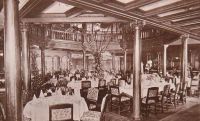Shown above, Clockwise from top left:
1. Mauretania Passenger List
- Dated from 8/27/1927, this is a passenger list from Southampton to New York. What makes it interesting
is that it has Andrew Cockburn as the Chief Engineer. He originally survived the sinking of the Lusitania and continued working
onboard the Mauretania.
2. Floral Pastel Snack Tray w/ Tea Spoon
3. Silver Sugar Bowl w/ Tongs
- The sugar bowl is dated from 1914, while the tongs are believed to be from the 1920s.
4. 2nd Class Menu - 12/21/1913
5. Floral Pastel Tea Cup & Saucer
6. Laurel Leaf Soup Spoon
7. Laurel Leaf Butter Knife
8. Floral Pastel Dinner Plate
9. Laurel Leaf Dinner Fork
10. Floral Pastel Saucer
11. Crystal Ashtray, c1910.

